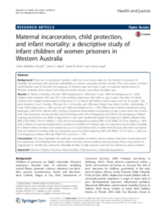Displaying 401 - 410 of 943
This paper discusses findings from a small-scale qualitative study conducted in Harare, Zimbabwe. Findings show that young people aging out from Harare’s care institutions face challenges making their transition from care into adulthood.
This study evaluates the ‘Nurturing Attachment’ program in the UK, a Dyadic Developmental Psychotherapy intervention for adoptive families.
This study draws on linked administrative data to describe the exposure of children aged less than 2 years to maternal imprisonment in Western Australia, their contact with child protection services, and infant mortality rates.
This paper presents findings from an 18-month randomized controlled trial in which intact families (N = 122) with at least one CPS report were provided with a facilitated connection to a paraprofessional evidence-based HV program or usual care services from child protection.
In this study, the authors examined the process of how relationships are built between Ethiopia adoptees and their adoptive families within the new family setting.
This study examined the prevalence of maltreatment and violent discipline from both the adolescents’ and parents’ perspectives.
In this article from the Child Law Practice Today July/August 2017 Issue on Kinship Care, Los Angeles Judge Michael Nash, Ret. shares court and agency strategies to engage and support relatives for children and families involved in the child welfare system in the US.
A First Nations child welfare organization has prioritized further understanding of reunification and parenting, including identification of successes and barriers to reunification, and service needs within communities. These priorities were addressed with a community-based participatory research model and guided by a Research Advisory.
This article outlines exploratory research in establishing a role for social work in child protection in Indonesia.
This is the first study in Ghana to explore child protection workers and parents’ experiences on participatory practices.

